Does a tree falling in an empty forest make a sound?
This is what the group’s final day alive looks like, according to the evidence found.
Their plan – and common sense – dictates to pitch the tent in the forest.
There was no bad weather, the group was well rested, and the total distance to travel that day was only two miles, with lighter backpacks. There was a new, more experienced member of the group, Zolotaryov, who had joined the trek because it was shorter and easier than the one he had enrolled for previously. He wanted to go back home. Even if Dyatlov could have convinced the rest of the group to make a challenging overnight on the ridge for no apparent reason, he wouldn’t have passed this through Zolotaryov, who was old enough to be his father. All members of the UPI sports club who had been with Dyatlov previous on winter treks testify that they always tried to pitch the tent between trees, where there was firewood and no less wind. This is a photo from the morning of February 1st.
See photos from another year of that same tent and stove the Dyatlov group was using on the fateful trek:
https://dyatlovpass.com/controversy#tentphotosThey had a short trek that day. The place for the overnight was good, with convenient access to water, and the Mansi had used it before to camp there, too. Grigoriev, while searching for the last four bodies, dug up an animal hide from under 5 feet of snow:
https://dyatlovpass.com/grigoriev-3#33The area around the famous cedar is described as showing signs of activity from many people. Some theories say the hikers, presumably in the dead of night, exhausted and barely clad, behaved as if they’d been blinded. There were a lot of broken branches, away from the cedar. Theories say there was a strong wind that blew the branches away and the hikers couldn’t find them. This to me sounds like trying to maneuver the facts into some twisted logic. Facts are that the most common behavior for the hikers would be to pitch the tent, gather firewood, go to the river for water, make a camp fire, install the stove, change from daily clothes into something they will spend the night in, take off their boots… What could have happened then to cause all the injuries? Some of them mortally injured and dying within 20 minutes from the trauma, according to the medical examiner, others running around till the hypothermia set in?
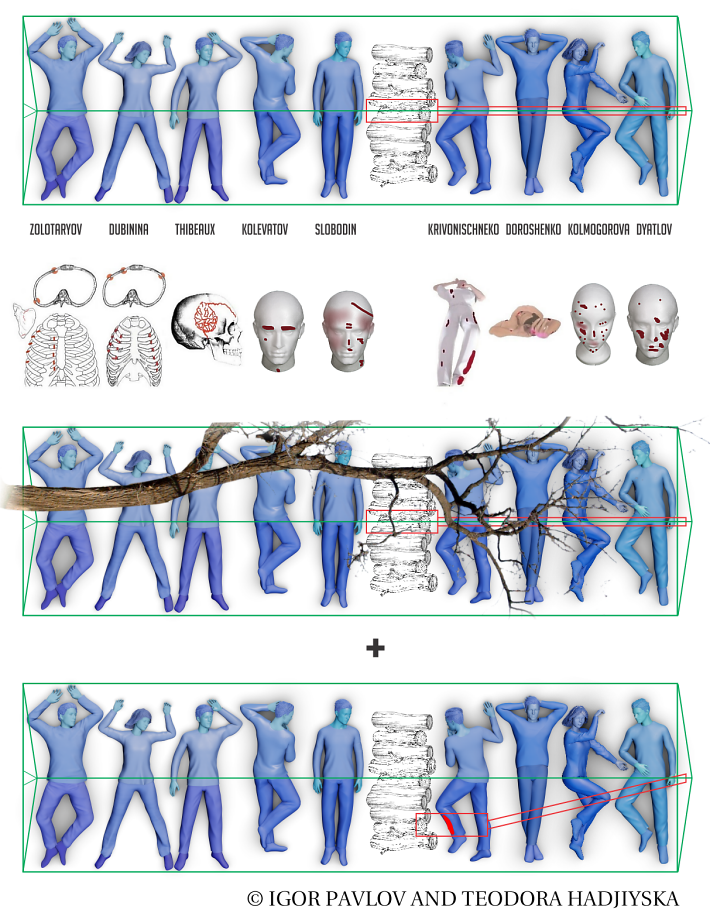
I have collected data from incidents with trees fallen on top of tents. Winds and snowfall are top on the list of factors. There are many fallen trees in the area of the incident. One much overlooked fact is how little snow there was on top of the bodies found in February and May. Two of them were barely dusted with snow according to the protocol of discovery and the photos. This is impossible if they had been lying there for a month.
I have uploaded some pictures so they don’t overload the document. They will not go in the book.
https://dyatlovpass.com/incidents-with-fallen-treesI started showing up at incidents sites with fallen trees on top of tents and befriending the medical examiners – they invited me to attend the autopsies. In the incident below, the woman dies without s single broken bone from mechanical asphyxiation. Somehow the tree propped itself but didn’t leave her enough space to breathe. There was gray foam coming out of her mouth. This is what Doroshenko had too. The conspiracy theorists say that may be because the CIA used to sit on the chest of a person during interrogations. Another wild interpretation is that Zina’s hair was messy because, the conspiracy says, whoever was after them roughed her up. This would be torture for a beauty like Zina, messing with her hair, as frightening as tearing the tongue out of Lyuda’s mouth. Things are not balanced in this case. Incidents with fallen trees are like the Rapture - one is gone, the one lying next continues living. This is one disaster that can affect people clustered together very differently.
During the autopsy I mentioned that I have 6 broken ribs and flail chest, like Dubinina, to instigate a comment on how they can tell old from new injuries. The medical examiner looked at me with dreamy eyes and said: “Your autopsy would be very interesting.” I got myself into an automobile accident hours later and the nearest morgue was the one I just had left. On the photo I am with the white Peugeot. The father of the woman driving the red car had died days before. She flew from Paris for his funeral. This is what he left her, the red car. It has been sitting in the garage for 10 years. She never thought of checking the tires, they were smooth as glass, it was raining; on braking she lost control and started spinning. I had all the time in the world thinking how interesting my autopsy will be.
In the photos the deceased in the orange pants was a poacher. He was not alone, one can tell from his position. He was pulled and then abandoned. Very much like Doroshenko and Krivonischenko.
I have the opinions of two medical examiners, both heads of major city hospitals with regional morgues. They both say that the injuries of the Dyatlov group could have been caused by a fallen tree. This proves nothing since they were not found under a fallen tree, but even if they had been, this would have just added to the autopsy report that the injuries do not contradict the scene of the incident. This would still not be definitive. Medical examiners are very careful about what they say. The terminology usually is “it doesn’t contradict” or “cannot be excluded”.
So, if they died by a tree, why were they not found under a tree?
“Those who know don’t talk. Those who talk don’t know.” - Lao Tzu
The problem with the theories in circulation is that the evolution chain of population goes from Yeti, Mansi, Gulag prisoners, straight to Komsomol, Moscow, CIA, KGB and next stop are the X-files. I am not exaggerating. The lead investigator Lev Ivanov wrote in an article
"On the scene of the incident we found that some young trees on the forest tree line have traces of burning, but they are not in concentric shape or any other system. There was no epicenter. This once again confirmed a source of heat ray or completely unknown to us energy acting selectively - the snow was not melted, the trees were not damaged. It seemed like when the hikers walked on their feet more than five hundred meters down from the mountain, someone dealt with some of them as direct targets..." Read the article →If this is what the lead investigator believed I would have closed the case too.
Lets we get back to reality, history and geology. We have to account for where and when the incident took place. The Ural Mountains are part of a highly developed industrial complex closely tied to the mineral-rich Siberian region and are the home of peoples with roots reaching deep into history. Beside the logging and forestry, there are many mining shafts and explorations.
These maps show the magnetic anomaly lines along which the helicopters were flying in 1959:
https://dyatlovpass.com/aeromagnetic-survey-mapsThe 21st Congress of the Communist Party of the Soviet Union was held from January 27 to February 5, 1959. It was a mid-term congress, timed so that Khrushchev could try to consolidate his power over rivals after the attempted coup of the Anti-Party Group in 1957. We know that the Dyatlov group dedicated their trek to the congress. The fact is even mentioned in their “Evening Otorten №1”. Similar tributes were very popular at the time. The Northern Geological Expedition wants to find ore and mineral deposits to glorify the Communist Party.
The most valuable resource was uranium. In case of checking a gamma anomaly, given the limited capabilities, the works might be done with a method borrowed from the practice of the leasing system of excavation of the radioactive ore by the MVD of the USSR in 1945-48,
“The works were conducted in the most primitive way – by manual short-hole drilling. Next, blasting out, collecting and sifting the chlopinite – a pitch-black uranium containing mineral. Antimagnetic anti-tank mines weighing up to 5 kg were used as explosives.” Hamza Fazylovich Syunikaev participated in the search. In 1959 he was a cadet of the division team in military unit 6602 (Ivdel). He remembers the cannonade of explosions that were so loud they had to send a request to Moscow to stop the blasting so they could work. The distance in his approximation was not more than 10 km from the search base camp, and the blasts were on the northern side of the ridge, on the side of the cedar tree. The searchers couldn’t stand it even though a mountain separated them from the explosions. The distance between Otorten and Dyatlov Pass is 13 km. The blasting was somewhere in between. The Syunikaev division was dropped on the pass at the end of February.
In 1959 Georgiy Vasilyevich Novokreshtyonov was a judge in Ivdel. He remembers Tempalov, the Prosecutor of Dyatlov case, talking about craters in the ground in the area of the incident.
Many aircraft were flying the skies above. In 1958 instead of retracing a map, a pilot offered Igor Dyatlov to fly him over the area to look around (
https://dyatlovpass.com/gallery-1958-Subpolar-Ural). In a rescue operation of another accident the military helicopters were flying along a planned route and they were used to exchange information with short wave radio station (
https://dyatlovpass.com/chivruay-incident-2#13).
At the beginning of February, during a routine flight to the geologist camp, the tent was spotted in the area of the cedar with a tree fallen on top. The normal procedure is to take the bodies to the nearest morgue in Ivdel.
Doctor Prudkov and nurse Solter were called to draw up the documents necessary for the burial of the dead hikers. In similar cases in 1946–47, the coroner and the head doctor of the local hospital were invited to Dombay, after which a “Burial Act” was drawn up with a description of the injuries. There are known cases of this type when no autopsy was performed; the examination was limited to a medical report, and there was no investigation.
"Cases of violent death that clearly resulted from reasons that do not entail any criminal liability, in particular as a result of natural disasters (floods, earthquakes, etc.), do not require the institution of criminal proceedings." (From the Instructions of the Prosecutor General USSR 1956-58.)
Some of the bodies were airlifted and brought to Ivdel morgue. Three of the bodies remained trapped in the tent under the tree. On their next drunken get-together, Sulman, Ivanov, Prodanov and Shestopalov decide that the blasting in the area caused the fall of the tree in violation of safety requirements. A decision was made at the level of Municipality, Northern Geological Expedition and Railway bosses to take over the discovery, transportation and preparation for burial of the bodies. This is a logical explanation why geologists, Ivdellag workers and Railway troops participated in the searches. Their behavior was strange in terms of searching practices. There is an underlying feeling of a cover up.
According to archival data, between January 1957 and February 1958, 435 cases of work-related injuries were recorded in the Ivdellag. Ten of them were fatal, five people were left with serious health problems. Eight people were charged, two were convicted. Ivanov knew this very well, the Head of the Administration of PO Box 240. And the sapper commander, Lieutenant Colonel Shestopalov, knew that under the Criminal Code of that time, "negligent attitude to the service of a person in command of the Workers 'and Peasants' Red Army in the presence of particularly aggravating circumstances entail the highest measure of social protection”. And complicity in war crimes of civilians entails a similar responsibility (Art. 193_1; 193_17 (b) of the Criminal Code of the RSFSR 1926). A Hero of the USSR Colonel of the Railway troops I. M. Shapovalov was convicted of a similar crime (death of subordinates in a fire) and was sentenced to 25 years in prison in 1950. Under the letter of the law, Sulman, Ivanov, Prodanov, and Shestopalov risked their heads. They decided to cover up the cause of death. In the USSR they did not cut deals for the first to sing. If one told the truth he himself would have suffered the same fate.
The Conspirators
| Geologists |
Ivdellag |
City Committee |
Railway troops |
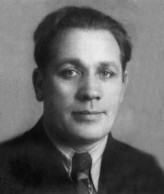 |
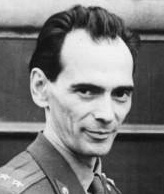 |
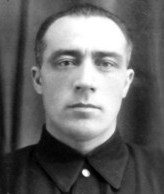 |
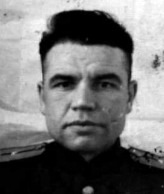 |
SULMAN
Abram Markovich
18.IX.1904 - 17.III.1983 |
IVANOV
Vitaliy Alekseevich |
PRODANOV
Ivan Stepanovich
1906 - IV.1964 |
SHESTOPALOV
Mihail Fyodorovich
1916 - |
Head of the Northern
Geological Expedition |
Lieutenant Colonel
Head of the PO Box 240 Administration |
First Secretary of the Ivdel
City Committee of the
CPSU |
Lieutenant Colonel
sapper commander leading group of 7 |
Sulman is the head of the Northern Exploration Expedition. The reasons for the active participation of geologists in the search are not clear.
Ivanov, Vitaliy Alekseevich. Lieutenant Colonel, Head of the Forestry Administration (PO Box 240) in 1959. He is the immediate supervisor of Cheglakov, the chief of the fire department of the Vizhay branch of PO Box 240. Not a single decision related to his subordinates could be made without Ivanov’s approval.
Prodanov - Secretary of the CPSU City Committee of Ivdel. The top communist in the area. He worked closely with the leaders of city-forming enterprises Ivanov and Sulman. Surely, they made all the important decisions together.
Geologists: Sulman is the Head of the Northern Exploration Expedition. Reasons for the active participation of geologists in the search are not clear. Nevolin (radio operator) took a direct part in the search, the Northern Expedition provided radio communications and negotiated the participation of the Mansi in the search and payment for their participation. All negotiations were conducted through the expedition chief Sulman.
Ivdellag: Cheglakov and guard troops. They were needed to protect prisoners and provide security, and were not enough as it was. Why did Vitaliy Ivanov agree to the participation of his subordinates in the search and the weakening of protection in the camps?
The conspirators needed time to draw up the necessary documents and bury everyone with compliance with all formalities before the arrival of the search group from Sverdlovsk. But they were cut shortly when on February 16 Blinov and Gordo from UPI got through to Hakimov, the Head of the Vizhay branch. In Ivdel, the local leaders realized that in about 3-4 days there would be a massive search for the missing group. The most obvious way out of this situation was to immediately report on the bodies of the hikers who died from natural causes – bad injuries from a fallen tree and hypothermia. But they had recovered only six bodies, three more were still trapped frozen inside the tent under the tree, a tell-tale scene for a criminal offence in their minds. All they had time for was to fly back the six bodies, cut up the tent, get the remaining bodies out, stage the tent for a death by a hurricane, and dump the bodies on the way to the ravine to copy the events from Fedoseev’s book. They already had traces from activity around the cedar and a den. This was perfect for the scenario. The rest had to stage up hastily the re-enactment on the slope of Kholat Syakhl. They didn’t have time to position the two Yuris properly. They were just left with their arms stretched up, the way you drag bodies around.
A lot of different geological work was carried out in the area. The bodies could be delivered to the pass area in boxes under the guise of some kind of equipment. The pilots did not know what they were transporting. And on the pass, boxes could be delivered by Mansi on a sled. In UPI was reported that the Bahtiyarov clan allegedly went out in search. Then it turned out they did not participate in the search. Maslennikov writes about this. The Bahtiyarovs might as well have helped transport bodies without knowing it. Some of them were nowhere to be found for questioning during the investigation.
The Radiogram
There is an interesting radiogram from May:
Received: Temnikov,
Stepanovich Prodanov
this is outrageous, fourteen comrades and I carried the corpses to the helicopter on our shoulders but the crew was ... more than dozen ... the helicopter lifted off, despite my convincing requests, they didn’t take on board what I had requested as a communist ... the crew’s behavior was insulting I ask you to inform the General Party of the Soviet Union and twice the hero of the Soviet Union, commander Col. General Lelyushenko.
for you personally. corpses are frozen in the state in which you saw them in ----- concerns their exposed parts of the body. we are not there ... guided by ... a detailed study showed that they are in a frozen state a medical expert --- refused to perform their resection because of the inability to do this, which he will personally report to you at your request
OrtyukovThe radiogram was addressed to Ivan Stepanovich Prodanov. It was received by Temnikov in the Northern Expedition (Ivdel), and it was definitely read by Sulman.
When could Prodanov or Sulman have seen the frozen corpses? This radiogram was sent after the pilots refused to take the bodies on board for transportation to Ivdel, and after Vozrozhdenny was summoned. There is no information about Prodanov or Sulman ever going to the pass in May, and Sulman has nothing to do with the search at all.
It is known that after finding the bodies Tempalov, Lev Ivanov and Vozrozhdenny flew to the pass. There are no recollections or documents about the arrival of Prodanov. An indirect fact in favor of his absence in May in the ravine is that Ortyukov had a heated argument with the pilots. Surely the local party leader would calmly resolve the issue.
The radiogram refers to the bodies found in May in the creek. The only time anybody could have ever seen these bodies frozen is before the official search for the Dyatlov group.
Railway troops: when sappers came to search in March, led by Lt. Col. Shestopalov, they examined this particular stream where the last four bodies were, and, of course, they didn’t find anything. Shestopalov behaved strangely, rendering himself and the rest of the sappers useless to the point that Maslennikov asked for the sappers to be ordered to start probing with avalanche rods. Shestopalov didn’t stick around. He left right after, as if not interested in the outcome of the search.
The Underlings
The only other presence in the area of the pass besides the hikers and the Mansi were the geologists blasting for ore and minerals. The leaders we suspect would have been involved in this operation. But there were also the people who worked there. There was no reason for them to know what’s going on, but the conspirators would need help to execute their plan. They wouldn’t do it with their own hands. Most likely, it was precisely those who participated in the blasting works that took a direct part in the staging. But they were a few. We deduced that two of the people that left their tracks on the slope below the tent were Pashin and Cheglakov, and there were probably two more. This explains their strange behavior. They were supposed to be guiding Boris Slobtsov and Mihail Sharavin, who allegedly discovered Dyatlov’s tent on February 26, but when they approached the location of the tent Pashin said he was tired, and Cheglakov excused himself that he felt sick. Sharavin remembers Cheglakov in particular being confused, idling and totally useless. Pashin and Cheglakov gave contradicting testimonies according to which they found the tent 2 days prior but didn’t tell anybody. It seems they were onto something. They were afraid of the same punishment as their bosses, and they kept to themselves. There must have been no more than eight people altogether that were in on the truth.
The plan was to prepare the bodies to be buried as unidentified hikers who died by their own negligence, in compliance with all formalities. A similar situation occurred in December 1961, when the cook of the detachment was killed in violation of safety requirements during an unloading operation from an airplane based on the ground detachment of geophysicists of the A. A. Latypov group. No investigation was conducted. The body was taken to Ivdel on a reindeer sled. No one was punished.
The tragic fact is that we will never know whether the explosions triggered the fall of the tree. But the Communist Party would look for scapegoats for the death of the hikers. They fired people from the top positions in the UPI sports club, when the deaths were caused presumably by a hurricane. Imagine what would have happened if there were explosions near the fallen tree that killed the hikers. The fear and panic of the local leaders led to such a bizarre outcome of the accident.
The Tent
Another hard to explain fact about the tent – the cuts form the inside. I don’t believe anyone would look for the exit to get out. The conspirators had 3 goals in mind, and they were achieved very successfully:
1 - The tent was taken away from the forest and the tree allegedly fell due to the blasting. The tree can be seen in the search photos but it is covered with snow. You can see it better in Yakimenko’s photos from 1963, when he went with a group of people to place the memorial plaque at Dyatlov Pass boot rock.
2 - The scene was staged for "death by a hurricane". It was very effective. This was the original cause of death adopted by the regional committee. The scenario was based on the book ‘On the Road of Trial’ (‘Тропою испытаний’) by Grigoriy Anisimovich Fedoseev, published in 1958, just months before the tragedy. Fedoseev is a fellow geodesist. The book was literally on their nightstand when all went down.
Excerpt №1 [
in Russian]:
We are ducking down in the manure. Vasiliy Nikolaevich pulls out an ax, cuts an icy mound, and he finds in fact sleds. On one of them is a tent, stove, saw, the rest are empty. Probably, the convoy, not reaching the pass by only two hundred meters, was caught by a blizzard. People managed to cut the straps on the reindeer, and they themselves fled to the taiga, for some reason without taking either a tent or a stove with them, without which, it seems, it is absolutely impossible to survive into this kind of cold. What happened to them further, it's scary to even think...Excerpt №2 [
in Russian]:
... A muddy curtain of bad weather appears on the horizon ... We corral into the tent, huddled around the stove, where a faint light flickers a little, casting a pale glow on the gloomy, alert faces of people... from the north a snowstorm approached. And soon everything was whistling around, spinning in a mad whirlwind. Streaks of snowy dust flowed through the frozen slant; snow drifting ominously.
The tent is arched from the pressure of the wind. The stove has gone out. Firewood is over, the cold finds a gap, seeps inside. We are wrapped in warm clothes. It is impossible to fall asleep, but the conversation is not getting better... what will happen if the wind breaks our tent and we find ourselves face to face with a snowstorm on bare rocks, far from the forest?...
A snowdrift piled up heavily on the tent on the windward side, the wall bent dangerously, and soon the rope in the middle broke, unable to withstand the weight... The hanging snowdrift had already taken a third of the site away from us and continued to press from above, bending the crossbar. It was at that moment that a new ferocious squall hit, and the canvas wall broke in half. A mountain of snow fell on us.
“Get dressed and go out!” Lebedev orders. A scuffle begins in the twilight, no one can find their belongings, you hear curses. The wind flaps the torn sides of the tent, throwing fistfuls of snow in our faces.
“I say, get out!” Lebedev's voice is heard through the howl of the storm.
“Presnikov, you are holding everybody back.”
“I lost my hat,” he screams back.
“Cover your head with a bag and get out!” orders Lebedev, wrapping a rope around himself and passing the end to his comrades.
The snowstorm brings down on us all its might. The chill is blinding the eyes, burning the nostrils. Lebedev is ahead, behind him, holding the rope, the others are walking. Moving almost blindly, it is difficult to get to the slope. It becomes easier to walk, because under your feet the descent and snowstorm are somewhat quieter here. We go at random among the small rocks, along hollows with steep slopes. Obviously, we descend down to the ravine, where there must be a forest, which means there will be a fire. We don’t dream about anything else... Only an hour later, the steepness of the descent broke, the placers and the rocks were left behind. Smooth drifted snow under our feet, slippery as ice ... We go down the ravine even lower and notice freshly cut stumps, and then tents are shown. Well done Kirill Rodionovich - how confidently he led us to the camp! And now we are at a great fun bonfire that has given us strength and good spirits. The ropes are untied, there is laughter...
... On the pass we saw snow mounds, like dunes of oblong shape, located in the direction of the wind. And where our tent stood, a frozen mound with an overhanging snow cornice towered ... We did not excavate the mound, it was late, and the snow hardened so much that it could only be cut with axes. We will do it tomorrow...3 - The tent was specially put out in a prominent place so it could be easily found. Officials from Sverdlovsk left Ivdel faster. Shortly after finding the tent and the first bodies, the locals were appointed to command the searches. All representatives of the regional committee returned to Sverdlovsk.
The footprints going down from the tent are the easiest to explain. The only person who said they were made by feet not wearing shoes was Captain Aleksey Alekseevich Chernyshov. His boss was Vitaliy Alekseevich Ivanov. Even without a direct order, one can easily assume the footprints had been left by the dead hikers who were found not wearing shoes. I am enclosing in the book the opinion of a forensic expert who says the footprints whose photographs we can see in the case files are from feet wearing shoes. Witnesses testify they could recognize 8 tracks. We believe they were left by four people going up and down i.e. 2x4. Also, Captain Chernyshov was the only one to testify there were no traces left by strangers. There is a footprint from a shoe with a heel. We don’t need to ask an expert about this one.
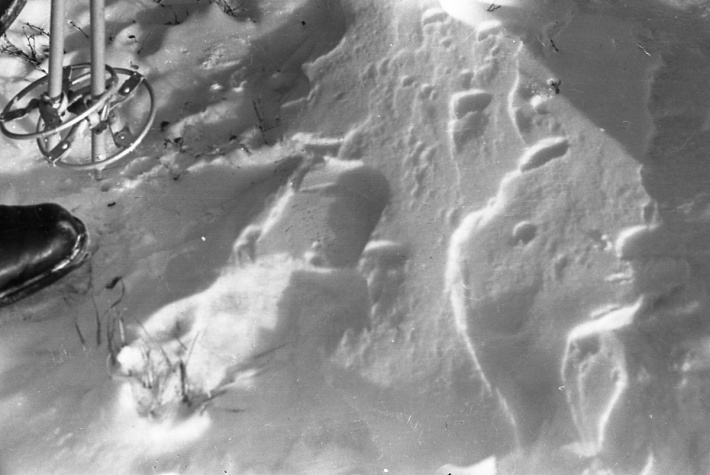
There were traces of men urinating. Such traces cannot remain for 3 weeks, not even slightly powdered by snow. The location where the tent was found is one of the windiest places I have ever been to. It is difficult to stand straight. The air is full of snow even when it is not snowing. The wind blows it from the ground, reshaping everything in its way. You can see the formation on the ridge, the memorial. The wind is in full power at this time of the year. Otorten means ‘The windy mountain’. “Don’t go there” is what locals say when you mention Otorten.
The legend of the 11 bodies
Former nurse in PO Box 240 (Ivdel) Pelageya Ivanovna Solter says she personally treated 11 bodies in Ivdel morgue. How is this possible?
From the interview with Pelageya Ivanovna Solter: “One girl was found with the guys, and the second girl was found 2 or 3 days later.” Solter’s interview was found unreliable and bewildering because she remembers taking off their clothes, the bodies being very dirty, washing them, preparing them for burial, and all this at night. Later the autopsy reports by Vozrozhdenny start with taking off the clothes and describing the contents of the pockets, the autopsies being performed in daylight.
P. I. Solter says in the early days of February 1959 six bodies were brought to the morgue in the zone; five bodies at first, amongst which there was a woman, and a couple of days later – another body of a woman. Dr. Prudkov is called to draw up the documents necessary for the burial of the dead hikers. This takes place in the morgue of the Ivdellag zone. Our conclusion is these are the bodies of Doroshenko, Krivonischenko, Kolmogorova, Dyatlov, Slobodin, and two days later – Dubinina.
A month later, on March 4, 1959, the bodies of Doroshenko, Krivonischenko, Kolmogorova, and Dyatlov were brought for autopsy. This time there is an ongoing investigation. Coroner Vozrozhdenny is called from Sverdlovsk to handle the procedure. Four days later, on March 8, the body of Slobodin was brought for autopsy. This takes place in a different morgue. There are two morgues in Ivdel, one for the Ivdellag (aka the zone), and one in the Hospital for the general population. Dr. Prudkov is not called this time. He would have recognized the bodies he had examined a month ago.
The total of these two events equals 11.
The four bodies that were dumped into the creek were officially found on May 5, 1959. This is two months later. They were brought to the morgue in the zone. As far as Ivdel residents were concerned, the search for the Dyatlov group was long over. Most likely, many did not know that someone else had been brought to the morgue in May.
Dr. Prudkov was not invited to see the bodies brought in May either.
In conclusion
The fall of the tree was accidental. Common causes are wind, snow, rotten trunk. The panic among the Ivdel leadership was due to lack of accurate and clear information at the time they made up their minds. Only geologists knew where exactly the incident took place. They found the bodies from the air and arrived at the scene for verification at the request of the police. All the rest - militia, Prodanov (party) and others knew only the “area of Mount Otorten”. For them Otorten, 1079, and the area of the prospecting ground check for the magnetic anomaly are approximately the same place. The difference could be understood by Sulman (head of the Northern Geological Expedition), but It is unlikely that he went into the details (coordinates) when sending employees on a ground check. The said leaders unambiguously connected Tempalov's story about the incident with the hikers with the blasting works in the area.
Imagine this: the sheriff's son goes to shoot rabbits “in the forest behind the house”. After a while, the sheriff finds John Doe body “in the forest behind the house”. Chances are the sheriff's first thought will be "my son accidentally shot someone". And taking in consideration the time (XXI congress of the party) and place (punishment means gulag) the sheriff will decide to move the body and hush up the case.
Dumping bodies is very common psychological behavior even if the person is not culpable for the accident. This is even considered lightening the significance of their actions since "they didn't do anything wrong". Also they didn't move the bodies - they "put them back where they took them from on first place". They only moved the tent.
In the literature there are many examples of body dump to make sure the dead are not found in the house or company of someone that doesn't want to get involved.
From "Unnatural death" by Michael Baden MD:
"It’s much easier to move the body somewhere else and go on with their lives.
… were amateurs, which is why the scene looked like murder. Amateurs always cause confusion. They don't realize the consequences of what they are doing."